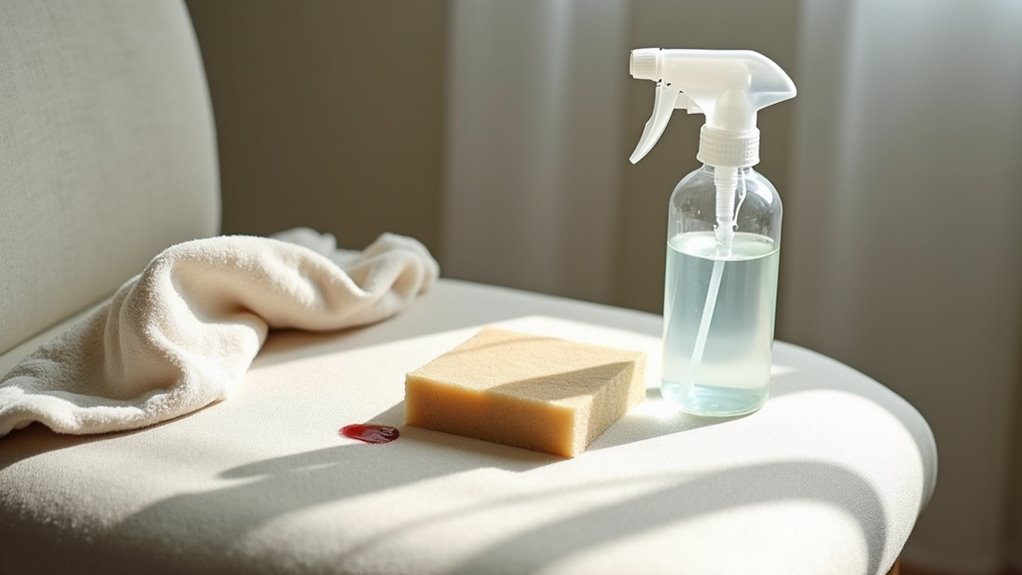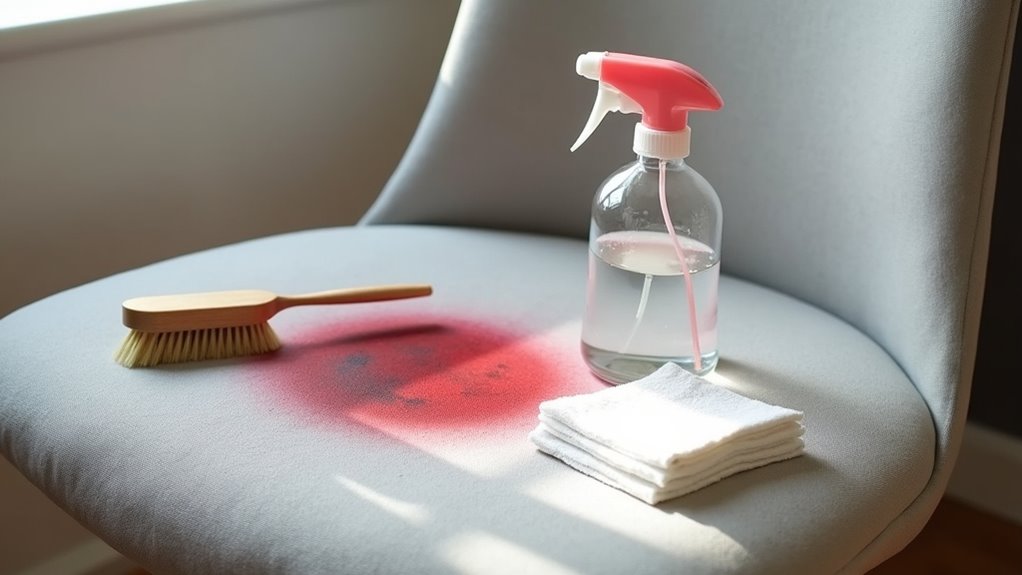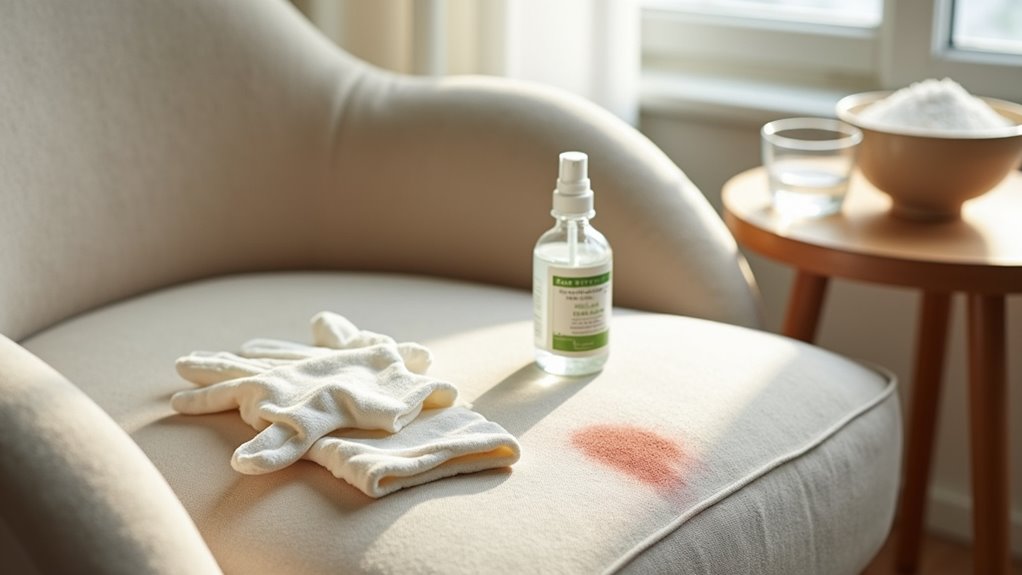How to Get Blood Out of a Fabric Chair
This post contains affiliate links. As an Amazon Associate, we earn from qualifying purchases.
To effectively remove a blood stain from your fabric chair, rinse it immediately with cold water—using hot water can make the stain worse. Blot the area gently with a clean towel to lift the blood without spreading it. For tougher stains, mix a gentle detergent with cold water and let it soak for 30 minutes. You may also consider using an enzyme cleaner or hydrogen peroxide, but be sure to test these on a hidden spot first. For those interested in more detailed tips and techniques, further explanations will follow in the article.
Essential Facts in 30 Seconds
- Rinse the stained area with cold water immediately to prevent setting.
- Blot the stain gently with a clean, white cotton towel to absorb blood.
- Apply a mixture of gentle detergent and cold water; soak for up to 30 minutes if needed.
- Use enzyme cleaners or hydrogen peroxide, testing on a hidden area first.
- Vacuum the chair after drying to remove dust and check for remaining stains.
Immediate Action for Blood Stains
Blood stains need quick action. Time is important! Start by rinsing the fabric with cold water right away. Hot water will make the stain worse. Rinse or soak for up to 30 minutes if the stain is tough.
Next, mix gentle detergent with cold water. Pre-soaking helps loosen the blood particles. The sooner you act, the easier it’s to remove the stain. Treat this like a quick mission. Work fast and make it fun! Remember that speed is crucial when dealing with blood stains.
Avoid heat until the stain is completely gone. Otherwise, it will stay for good.
Blotting and Absorption Techniques

Blotting is a powerful tool for removing blood stains quickly! Using the right techniques can help a lot.
Here’s how to handle those tough stains with some smart absorption methods:
- Use a clean, white cotton towel. No colors, please!
- Blot gently. Rubbing pushes the blood deeper.
- Apply even pressure. Soak up as much blood as possible.
- Change towels often. This keeps the stain from returning.
- Use cold water for blotting. Hot water sets the stain!
Start at the edges and move inward. Think of it as giving the stain a gentle goodbye hug. Remember that immediate action is crucial to prevent the stain from setting.
The faster you act, the better your chances! With these steps, you’ll become a pro at making blood stains disappear like magic.
Good luck with your stain-fighting mission!
Effective Chemical Cleaning Agents
Got a stubborn blood stain? No worries! Enzyme cleaners are your best friends. They break down protein stains easily. Just follow the instructions on the bottle.
For a homemade solution, try hydrogen peroxide. It can be very effective. Test it on a hidden spot first, especially on dark fabrics. It might lighten them.
Another great option is a mix of glycerine, laundry detergent, and cool water. This combination works well without harming your fabric. Remember, understanding fabric traits can help you choose the right cleaning method for your specific upholstery.
Always check your fabric type before starting. Avoid harsh chemicals like bleach.
With these tips, that blood stain will be gone in no time! You’ve got this!
Advanced Stain Removal Methods

Cleaning blood stains can feel tough, but you can win this battle with the right techniques. Acting fast is key. Follow these steps for effective stain removal:
- Gently blot the excess blood with a clean cloth.
- Use cold water to dab at the stain. This helps dilute it.
- Always test cleaning solutions on a hidden spot of fabric first.
- Rubbing alcohol or hairspray can lift the stain. Blot afterward to remove excess.
- Sprinkle baking soda on the stain and work it in gently.
Avoid scrubbing too hard. It can spread the stain. If the stain remains, repeat these steps. Each round brings you closer to victory.
Gather your supplies and say goodbye to that stain!
Drying and Final Cleaning Steps
After removing that tough blood stain, it’s time to rinse!
Use cold water to wash the area well. This helps get rid of any cleaning solution left behind. Rinsing is an important step.
Next, let your fabric air dry.
Avoid using heat. Heat can make the stain stick, and we don’t want that!
Follow these steps, and your fabric should look good as new.
Rinse With Cold Water
Rinsing out blood stains with cold water works wonders. Cold water stops blood proteins from sticking to fabric. This makes it easier to remove the stain.
Follow these steps to get the best results:
- Blot the stain gently with a clean, damp cloth.
- Wet the area well to loosen dried blood.
- Rinse thoroughly after your first attempts to remove residue.
- Keep rinsing and blotting to lift the stain faster.
- Don’t soak the fabric unless it can handle it.
Use these tips to tackle stains like a pro! Roll up your sleeves and watch that stain disappear! You can do this!
Air Drying Techniques
After rinsing out that stubborn blood stain, focus on air drying your fabric. Start by opening windows and using fans. This boosts airflow without using heat.
Pat the fabric gently with a clean, dry cloth to remove excess moisture. Remember, rubbing can damage the fibers. A dehumidifier helps control humidity, making drying faster.
Watch the drying time closely. Thick fabrics may take longer to dry, so be patient.
Once dry, vacuum your chair to remove any dust or dirt. Check for leftover stains too. Avoid heavy use right away. Give the fibers time to recover.
Follow these steps, and your fabric will look great!
Prevention and Maintenance Tips

Keep your fabric fresh and clean with a regular cleaning schedule. Regular cleaning helps to maintain fabric longevity. Additionally, vacuuming regularly can prevent dirt from embedding in the fabric and make stains easier to remove.
Use fabric protection treatments to guard against stains.
Act quickly on spills. This helps stop blood marks before they set in.
Think of it as a superhero team for your upholstery. This team keeps your furniture safe from spills and stains.
Enjoy your space without worry. Taking these steps can make a big difference. Your fabric will stay looking great for a long time. Regular cleaning contributes to comfort and productivity in your workspace.
Regular Cleaning Schedule
Keeping your fabric fresh and clean is easy. Regular care makes a big difference!
Follow these steps to keep your upholstery in top shape:
- Vacuum with an upholstery attachment. This catches dust and pet hair before they settle.
- Rotate and fluff cushions. This helps them keep their shape and reduces wear.
- Spot clean spills right away. This stops stains from becoming permanent.
- Blot stains gently with a clean cloth. Rubbing can make stains worse. It’s important to avoid oversaturating the fabric to prevent mildew. To maintain the fabric’s integrity, be cautious about using suitable cleaning solutions during spot cleaning.
- Use a mild, fabric-safe cleaner. This protects your chair’s material during quick clean-ups.
- Consider fabric delicacy when choosing cleaners to avoid damage.
With this routine, your chair will look sharp for years! Enjoy your clean and cozy space.
Fabric Protection Treatments
You’ve worked hard to keep your fabric clean. Now, treat it to some protection! Start with a good fabric protection spray. This spray creates a barrier that keeps liquids away.
For even better results, use a professional-grade coating. These last longer and protect against spills effectively.
Reapply the treatment every 3 to 6 months, especially in busy areas. Apply it evenly to all fibers. Avoid using too much, or your chair might feel sticky.
Protecting your fabric helps prevent stains. It also makes vacuuming easier. Keep those spills away. Your chair will appreciate it!
Immediate Stain Response
A blood stain on your favorite fabric chair can be scary, but staying calm helps. Quick action makes a big difference. Here’s what to do for effective stain removal:
Blot the stain gently with a clean cloth. This helps absorb the blood. Use cold water to rinse the area. Warm water can make the stain set.
Keep the area dry between blotting. This stops the blood from soaking deeper. Never rub the stain. Rubbing spreads the stain or pushes it in further.
Switch to a fresh cloth as it gets wet. This prevents re-depositing blood.
Act fast to keep your chair looking great. You can handle those tough stains like a pro!
Frequently Asked Questions
Can I Use Warm Water to Remove Blood Stains?
Warm water can help remove blood stains, especially if they are dried. It softens the proteins in the blood. For fresh stains, use cold water. Cold water stops the stain from setting in. Always act quickly for the best results. Soak the stained area in cold water first. Then, use warm water to clean it. This method works well on most fabrics. Always check fabric care labels before cleaning.
What if the Blood Stain Has Already Dried?
Dealing with a dried blood stain can be tricky, but it’s possible to remove it. Start by gently scraping the stain with a dull knife. This helps lift some of the dried blood.
Next, use hydrogen peroxide. Pour a little on the stain and let it sit for a few minutes. The bubbles will help break down the blood. Blot the area with a clean cloth after a few minutes.
Rubbing alcohol is another option. Apply it to a cloth and dab the stain. This method works well for tougher stains.
Always test these methods on a small, hidden area of the fabric first. This way, you won’t damage the material. Patience is key. Sometimes, you may need to repeat these steps for the best results.
Are There Specific Fabrics That Are More Stain-Resistant?
Stain-resistant materials are essential for keeping your spaces clean. Polyester, microfiber, and olefin are great choices. These fabrics are strong and help protect against spills. They work well in busy areas like living rooms or dining rooms.
Polyester is popular because it resists stains and is easy to clean. Microfiber is soft and very durable. Olefin is known for its resistance to moisture and dirt. Each of these fabrics helps you avoid tough cleaning jobs later. Invest in stain-resistant fabrics to save time and effort. Enjoy a clean, worry-free environment with the right materials.
How Long Should I Let Cleaning Solutions Sit?
For good stain removal, let cleaning solutions sit for the right amount of time. Glycerine works right away. It doesn’t need to sit. Ammonia takes longer. It needs about 30 minutes. Always follow cleaning instructions. This helps you get rid of stains better. Choose the right cleaner for your stain type. Each cleaner acts differently. Patience pays off when dealing with tough stains.
Can I Use Bleach to Remove Blood Stains?
Bleach can remove blood stains effectively. But, it might not be safe for all fabrics. Some fabrics can get damaged by bleach. Oxygen-based cleaners are good alternatives. They are gentler and still remove stains well.
Always test a small area first. This helps to check if the fabric can handle the cleaner. Different methods work for different stains. For blood, cold water is best. Rinse the stain with cold water before using any cleaner.
Conclusion
Tackling blood stains on your fabric chair can feel like a superhero mission. Gather your supplies and get ready to act fast. The quicker you clean the stain, the better your chance of success.
Start by blotting the stain with a clean cloth. Do not rub. Rubbing can spread the stain and make it worse. Use cold water to help lift the blood. You can also mix a little dish soap with water for extra cleaning power.
If the stain remains, try hydrogen peroxide. Test it on a hidden part of the chair first. Apply it directly to the stain and blot gently. Rinse with cold water afterward.
Patience is key. Some stains take time to disappear. Keep working at it, and don’t give up. With the right techniques, your chair can look great again. Your efforts will pay off, and your chair will thank you for it!
